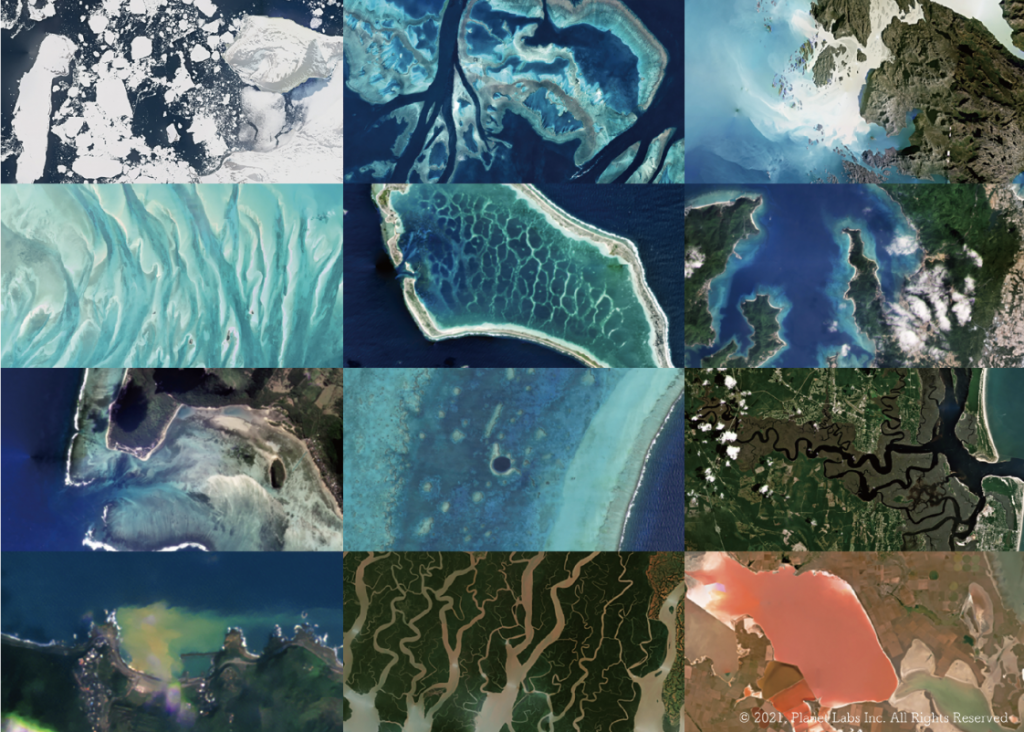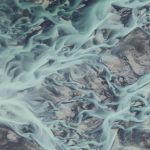Crayons of the Seas: A Visual Exploration of Marine Biodiversity with Satellite Imagery
What do crayons, satellites, and marine biodiversity have in common? The Crayons of the Seas project by SKY Perfect JSAT, one of Asia’s largest satellite communication companies based in Japan. Crayons of the Seas is a science-meets-art collaboration that created one-of-a-kind hues of biodegradable crayons representing twelve colors of the ocean based on Planet’s satellite imagery of our watery highways.
The Crayons recently won accolades from the likes of iF Design and Red Dot, but it’s not just the creative design that’s turning heads. What started as spur-of-the-moment inspiration was also a matter of urgency. “Because the 12 colors in the crayon box are colors produced by nature, they may never be seen again if the environment changes,” said Shoichiro Seino of SKY Perfect JSAT, the crayon project’s primary designer. “These colors are treasures of the earth, and we hope that interest in these colors, the environment and creatures that produce them will lead to the preservation of these colors and their ecosystems.”

From Curiosity to Crayons
Seino was looking through Planet’s satellite imagery when he came across a literal red sea. Locally dubbed the “Rotten Sea” of Ukraine, otherwise known as Sivash Lake, the saltwater lagoon on the west coast of the Azov Sea emits a foul smell during summer months due to its shallowness. The lake is famous for its rare pink-tinted salt that causes the water’s reddish tone. Its unexpected crimson shade surprised Seino and made him wonder if there are other seas of various colors. He browsed through Planet’s Gallery and found a myriad of sea colors –– golden, black, and green.
“I wanted children to know about the diversity of the earth, and so I came up with the idea of putting the colors of the oceans into crayons,” Seino said. But why were the colors that way? Where were they? For that, he took a collaborative approach by consulting experts and embassy officials to unpack what would go in the pack.
The 12-color palette of Crayons of the Seas with the corresponding Planet satellite images they represent.
But why crayons, and what does it have to do with marine conservation? The creatives behind this project wanted to develop an educational experience for kids because “crayons are among the first art supplies children pick up.” By providing them with an immersive learning opportunity, they could nurture an awareness and appreciation of the natural world from an early age. In addition to the inspired color palette, the packaging was designed to provide information like the location pictured in the satellite imagery and the environmental issues facing those waters. The team hoped that this feature would spark curiosity in learning more about marine biodiversity.
Deeper Than Surface Colors
For the SKY Perfect JSAT team, the project means more than producing beeswax-based crayons. The development team distributed free sets of crayons to elementary students in Amami Island in Japan, the subject of one of the inspiration satellite images, and conducted community workshops to pique their interest in environmental advocacy.
Aside from the educational campaigns, portions of sales go to several beneficiaries, such as the Republic of Kiribati, a country in danger of rising sea levels. Choosing Kiribati was a conscious choice to complement the product’s awareness goal of preserving the environment. Through this initiative, SKY Perfect JSAT’s team “wanted children to know that there is actually a country that could sink and disappear due to global warming”, said Yukiya Hanada. The team plans to continue sending proceeds from the sales of Crayons of the Seas for sustained support to Kiribati.
Commitment to The 2030 Agenda
We have an edge in reversing the adverse effects of climate change in marine ecosystems, and one of those is access to big data, particularly via satellite imagery. As we say at Planet, you cannot measure what you cannot see. Sometimes that’s with optical imagery and sometimes that’s with the scribble of a crayon. With less than seven years until the deadline for The 2030 Agenda for Sustainable Development, Planet remains committed and proactive in finding ways to work together with our customers and partners like SKY Perfect JSAT to reverse climate change.
Crayons of the Seas is a testament to how the creative possibilities of satellite imaging know no limit. We continue to push the boundaries of satellite imaging by refining our geospatial data capabilities, such as high-frequency imaging, near real-time monitoring capabilities, fine spatial image resolutions in multiple spectral bands, change detection analysis, and integration with other input sources for easier validation and calibration of data to generate more accurate assessments of environmental impacts.
What’s Next for Crayons of the Seas?
We are proud to share that the collaboration’s ingenuity and craftsmanship were internationally recognized by various award-giving bodies, including iF Design Award 2023 (Germany), Red Dot Design Award 2022 (Germany), Good Design Award 2022 (Japan), Kids Design Award 2022 (Japan), 31st Stationery of the Year 2022 Design Category Award Winner (Japan), and Stationery General Election 2022 Grand Prize (Japan). This recognition would not be possible without Sky Perfect JSAT and their hardworking collaborators: Toichi Bungu Co. LTD, Fukunaga Print Co. LTD, especially the creative minds of Masaya Ishikawa, Hokori Iinoda, and Yuria Takayama.
But this is not the end because the SKY Perfect JSAT team produced another set of crayons inspired by the colors of the mountain. This set posed more creative challenges since the colors of the mountains change more dramatically and frequently than the oceans.
“Like with the Crayons of the Seas project, Planet plans to support this process that will continue to educate the next generation of climate advocates,” said Mayumi Kashima, Planet’s Customer Success Manager for Sky Perfect JSAT. Feeling inspired to explore the colors of the seas and mountains yourself? You, too, can take inspiration from various satellite images available on our website gallery and start your own colorful project.




